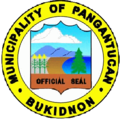Top Qs
Timeline
Chat
Perspective
Pangantucan
Municipality in Bukidnon, Philippines From Wikipedia, the free encyclopedia
Remove ads
Pangantucan, officially the Municipality of Pangantucan (Cebuano: Lungsod sa Pangantucan; Tagalog: Bayan ng Pangantucan), is a municipality in the province of Bukidnon, Philippines. According to the 2020 census, it has a population of 56,580 people.[4]
This article needs additional citations for verification. (June 2014) |
Remove ads
Remove ads
History
The indigenous groups of Pangantucan are various Talaandig and Manobo tribes.[6][7] It has also been settled by Dumagat (Visayans) in recent times.[6]
The name “Pangantucan” means wisdom and strength in the Manobo languages and is said to refer to a white stallion that uprooted a bamboo stalk to warn his master, a tribal datu, of approaching raiders from other tribes.
Pangantucan was previously a barrio of Maramag. It was merged in 1931 with Adtuyon, Dominorog, Panalagsagan, Kalilangan and Barandias to form a separate municipal district. It was granted Municipal status in 1961.[8]
Remove ads
Geography
Summarize
Perspective

Pangantucan is situated in south–western Bukidnon and located approximately 75 kilometres (47 mi) south of the provincial capital Malaybalay.
Pangantucan shares borders to its south-west and south with the provinces of Lanao del Sur and Cotabato. Within Bukidnon, Kalilangan lies west of Pangantucan while on its north-west is Mount Kitanglad. Valencia is located to the north while Maramag, Don Carlos and Kadingilan are located to the east and south.
Pangantucan has a land area of 46,172 hectares (114,090 acres), making it the ninth largest component subdivision of Bukidnon.
Pangantucan is also home to lakes Napalit and Mata, which are located at a distance of one kilometer from each other in Barangay Pigtauranan. Lake Napalit is a tectonic lake situated outside Mount Kalatungan. It has an estimated area of 36 hectares and a depth of 80 feet and also contains an islet. In between the two lakes is a marsh containing naturally bonsai-ed trees and tikog plants.
Barangays
Pangantucan is politically subdivided into 19 barangays. Each barangay consists of puroks while some have sitios.
Topography
Pangantucan is characterized by hilly and mountainous areas. To its north-west portion is Mount Kalatungan, the second highest peak in Bukidnon with an elevation of 2,824 metres (9,265 ft).
Climate
The climate of Pangantucan is of Type IV of the Modified Corona's Climate Classification. It is characterized by more or less evenly distributed rainfall throughout the year with rare incidences of tropical cyclones. Rainfall is influenced by the rain shadow generated by the mountain ranges of eastern Bukidnon and adjoining highlands.
Remove ads
Demographics
In the 2020 census, the population of Pangantucan was 56,580 people,[4] with a density of 120 inhabitants per square kilometre or 310 inhabitants per square mile.
Economy
Poverty incidence of Pangantucan
10
20
30
40
50
60
2000
55.17 2003
53.21 2006
41.60 2009
53.19 2012
51.66 2015
49.10 2018
31.70 2021
31.86 Source: Philippine Statistics Authority[14][15][16][17][18][19][20][21] |
Notes
- In hiding since December 20, 2024[2]
References
External links
Wikiwand - on
Seamless Wikipedia browsing. On steroids.
Remove ads





